Follow this simple recipe and video tutorial for the best all butter pie crust. It will make you a pie expert immediately! Complete with all my tips and troubleshooting, this pie crust recipe is buttery, flaky, and tender with the most incredible flavor.
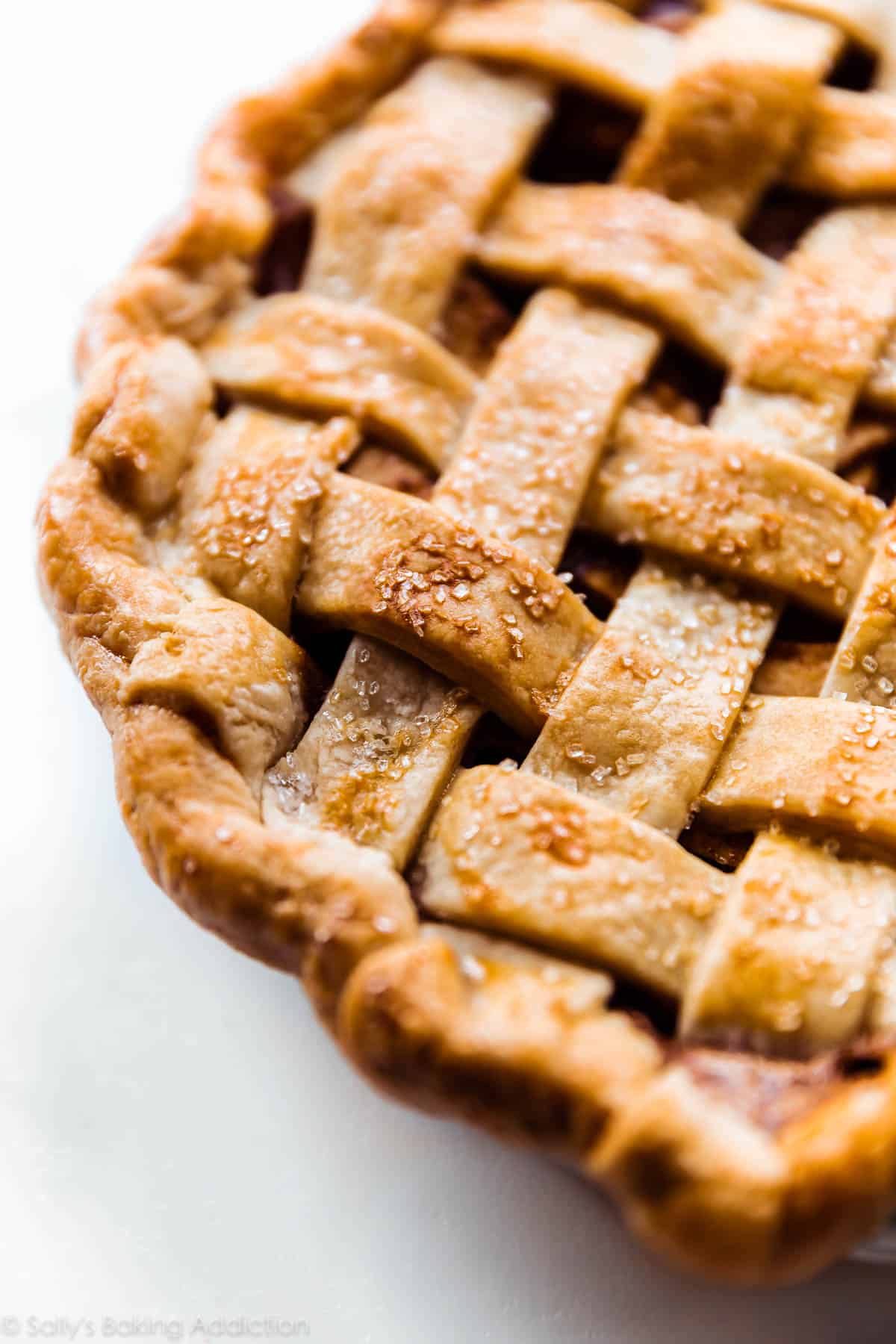
At the request of many, today I’m sharing my go-to all butter pie crust recipe. It competes with my butter and shortening pie crust for the #1 spot in my pie-loving heart. (Scroll to the recipe notes for my pie crust comparison!) I’ve made thousands of pies in my day and consider myself a pie expert. A pi-expert, if you will. I’ve made all the pie crust mistakes so I can coach you through the process and supply you with all the knowledge and confidence to tackle pie crust once and for all.
You’ll be a pi-expert with this recipe and tutorial on your side!
Watch my video tutorial for butter pie crust with lattice topping. This is my homemade apple pie with chai spices, a favorite every Fall season.
Start with a dependable pie crust recipe and you’re set for success. Soon everyone will be asking YOU for all your pie crust secrets.
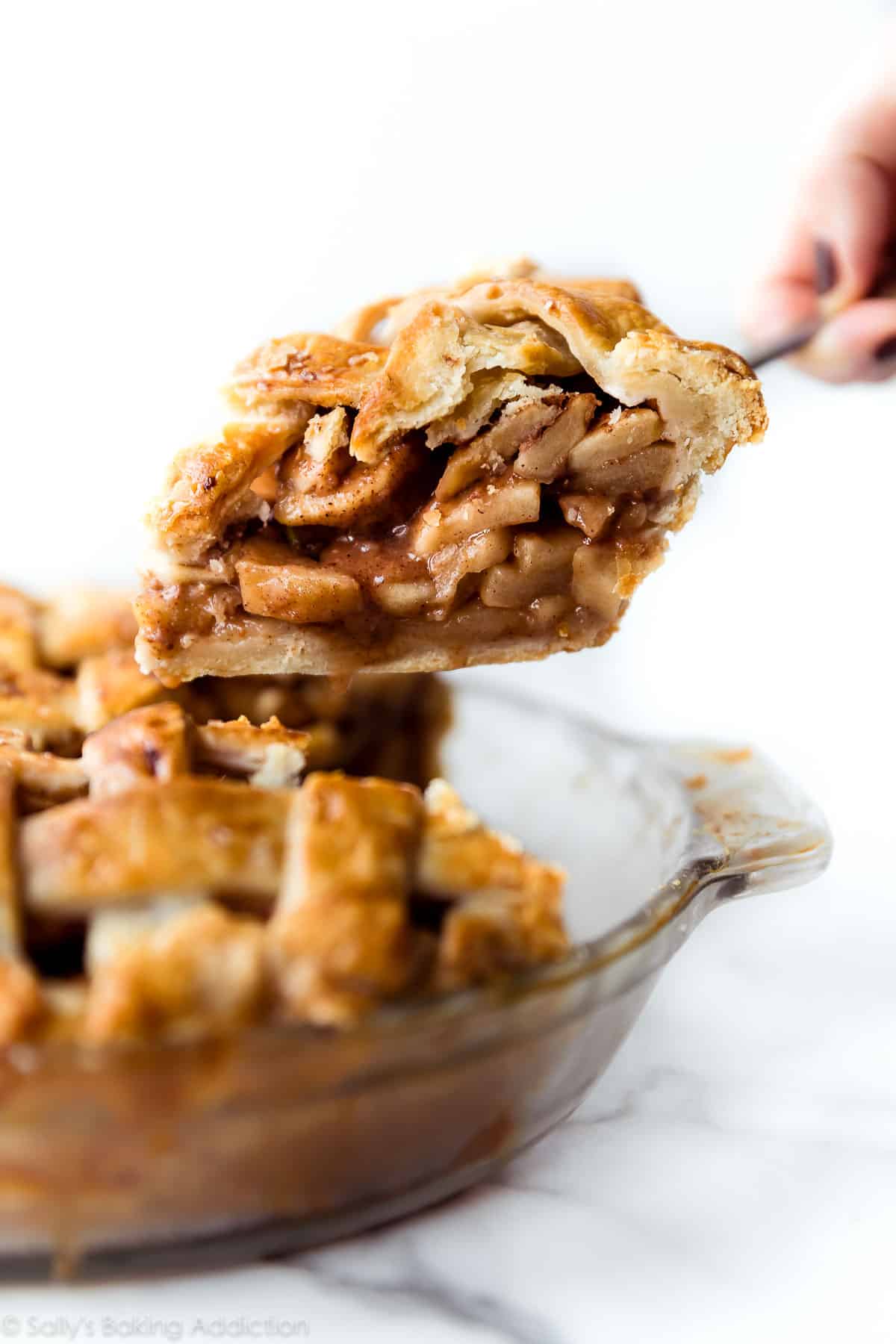
Only 5 Ingredients in Butter Pie Crust
This pie crust is made with 5 ingredients. Each ingredient has a very specific job. And with so few ingredients, it’s important to use the best quality.
- Flour – The structure of pie crust.
- Salt – Flavor flavor flavor. Use table salt instead of coarse salt. Smaller salt crystals dissolve and disperse more evenly throughout the dough.
- Granulated Sugar – Pie crust should not be sweet, but adding a little sugar to butter pie crust improves its flavor and enhances browning. The sugar crystals also help break down the hard pieces of butter.
- Cold unsalted butter – Supplies the pie crust’s unbeatable flavor and flaky texture. Use unsalted butter. The amount of salt in different brands’ salted butter varies, so for better control over the flavor, it’s best to begin with unsalted and add your salt.
- Ice water – The final ingredient, about 1/2 cup of ice cold water holds all the ingredients together. Use just enough so the dough holds its shape when rolling out. Many pie crust recipes don’t call for enough ice water, giving you a dry pie dough that cracks when you roll it out. When in doubt, add a little more water. You’re better off with more water (wet pie dough) than not enough water (dry, cracking pie dough) because you can always work more flour into the dough, but you can’t really add water to the pie dough when you’re trying to roll it out.
I use this crust in my apple cheddar pie—there I add some sharp cheddar cheese. It’s also the starting point for chocolate pie crust that we use for chocolate pop tarts!
Basic Pie Crust Steps
- Mix dry ingredients together.
- Cut in the butter with a pastry cutter or food processor.
- Add ice water a little bit at a time until the dough begins to come together. It will feel thick and moist, not overly wet. You’ll use around 1/2 cup (120ml).
- Mold pie dough into a ball.
- Cut in half. This recipe yields two 9-inch pie crusts.
- Flatten into discs. Wrap in plastic wrap.
- Chill for 2 hours before using.
These steps are shown in the video tutorial above and described in the recipe below.
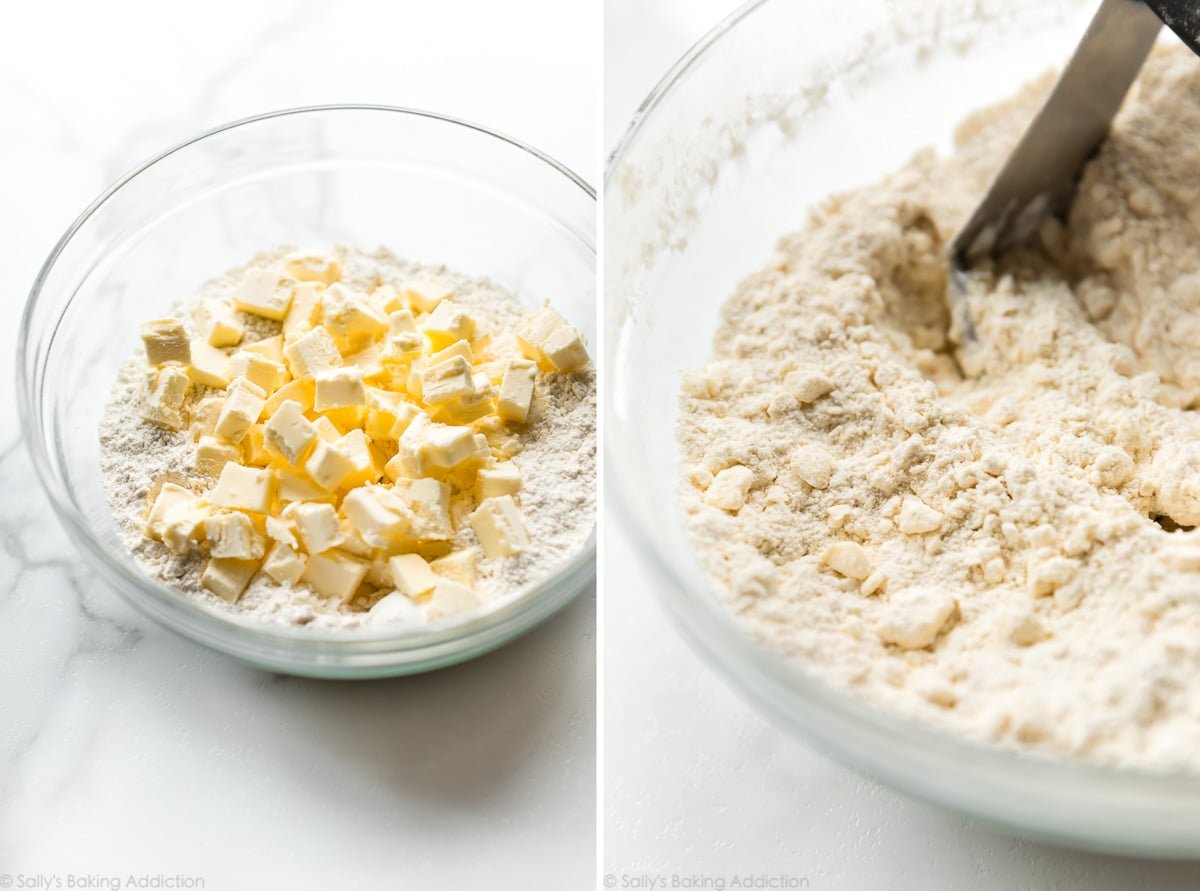
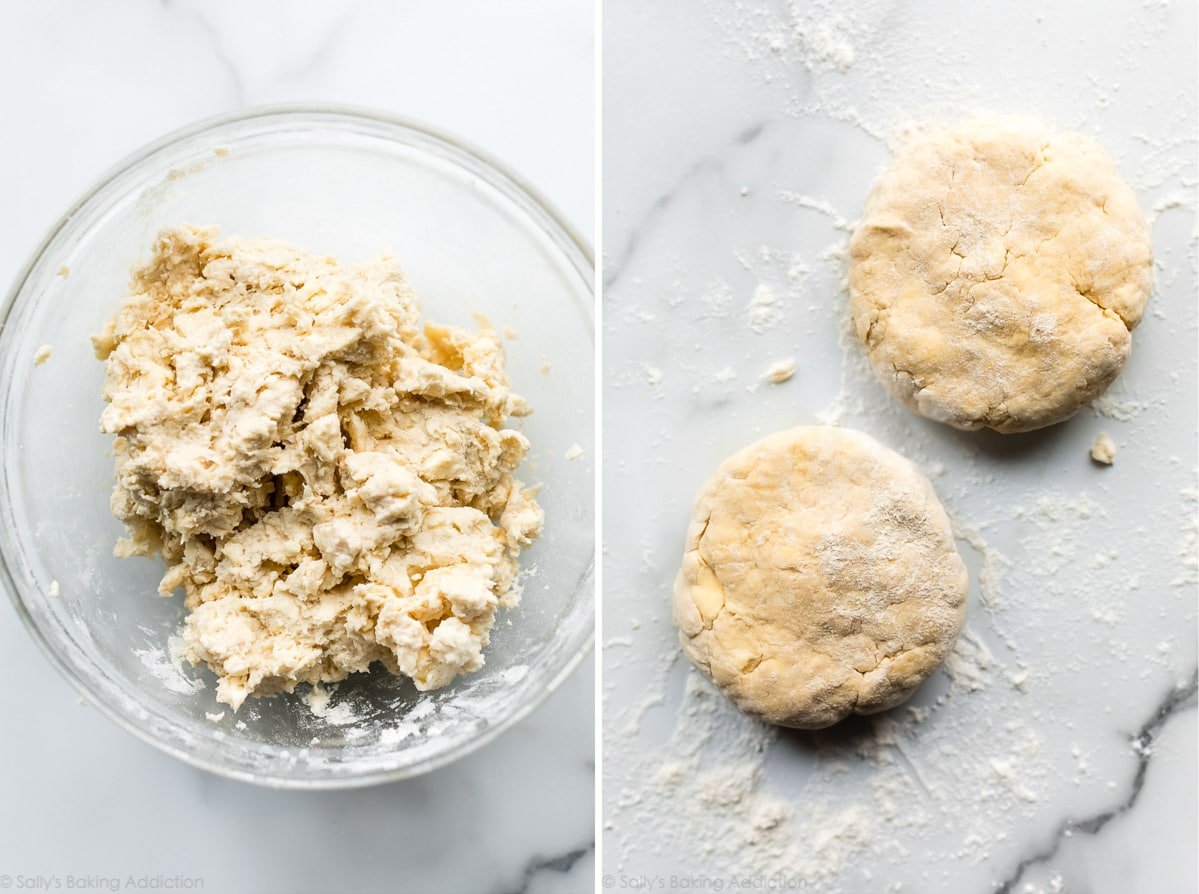
Why the Emphasis on Cold?
Keeping your pie dough as cold as possible prevents the fat from melting too soon. Too soon = before the pie crust enters the oven.
- What happens when the pie dough is warm? The butter in the pie crust will melt before baking, which means you lose all the flakiness and structure. Warm pie dough melts into a pool of grease. You’ll have a hard, crunchy, and greasy crust instead of a beautifully tender flaky crust.
- What happens when the pie dough is cold? The butter in the pie crust will melt inside the oven. Butter has a high volume of water content and this water converts to steam as the pie dough bakes. The steam separates the crust into multiple flaky layers, making this the most delicious pie crust ever.
The colder the dough, the flakier the pie crust.
How to Keep Pie Dough Cold:
- Use ice cold water. Fill a glass with 1 cup of water, add ice. You only need 1/2 cup of water in this butter pie crust recipe, but have a little extra just in case.
- Use cold butter. I keep some of my butter in the freezer and transfer it to the refrigerator a couple hours before beginning the crust. The butter is part frozen and very cold.
- Chill the pie dough for at least 2 hours before rolling out. This step is non-negotiable; it’s the most crucial in the entire pie crust recipe.
- For extra insurance, chill your flour and your mixing bowl in the refrigerator or freezer. Sounds a little silly, but trust me… it really helps!
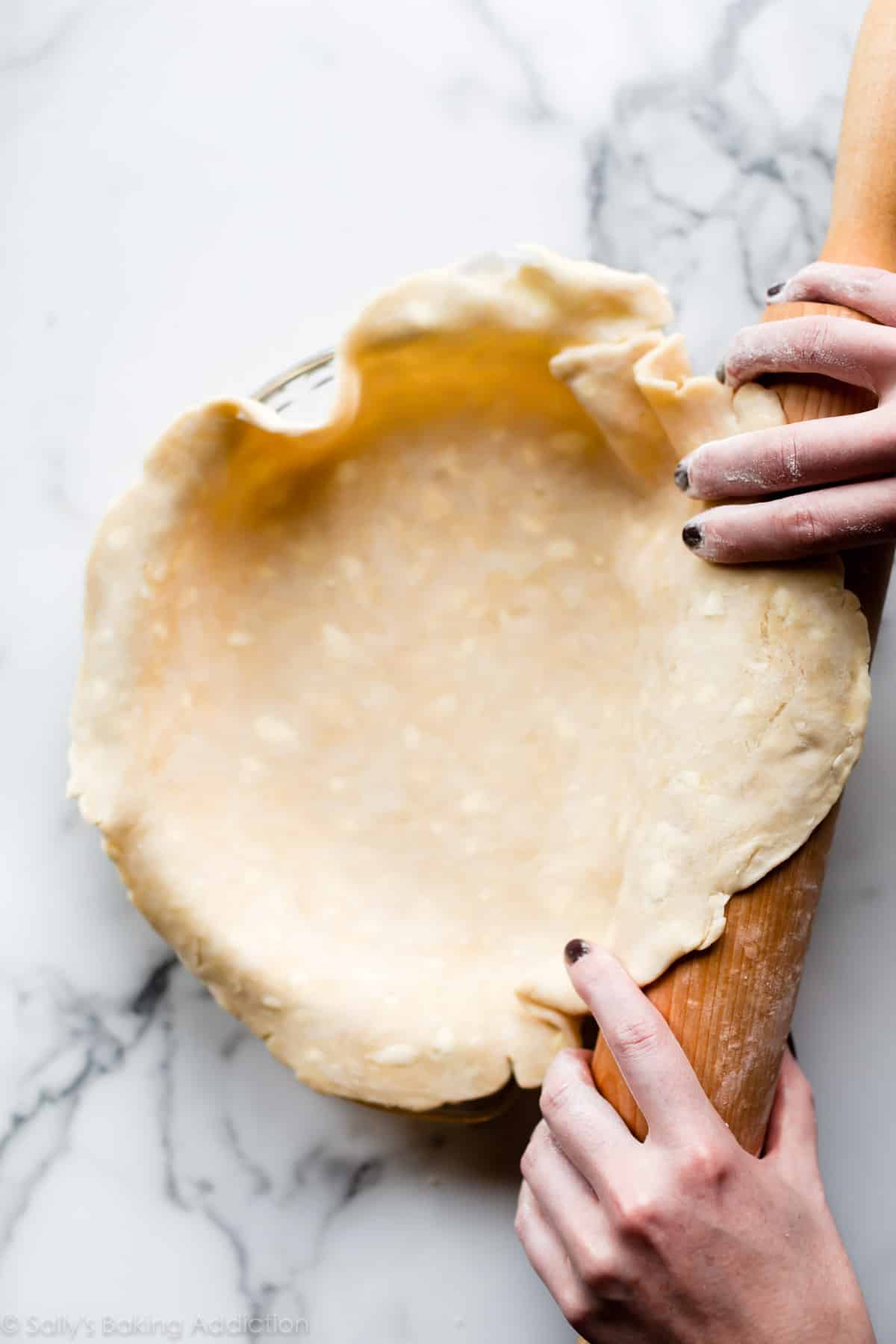
How to Roll Out Pie Dough
After the dough has chilled, it’s time to roll it out. Keep a small bowl of flour nearby to keep your work surface, rolling pin, and hands lightly floured. This prevents the pie dough from sticking. When rolling pie dough out, always start from the center and work your way out in all directions, turning the dough as you go. If the pie dough feels too warm or the butter is melting, stop. Lift it up, place on a baking sheet, and chill in the refrigerator for at least 10 minutes before continuing.
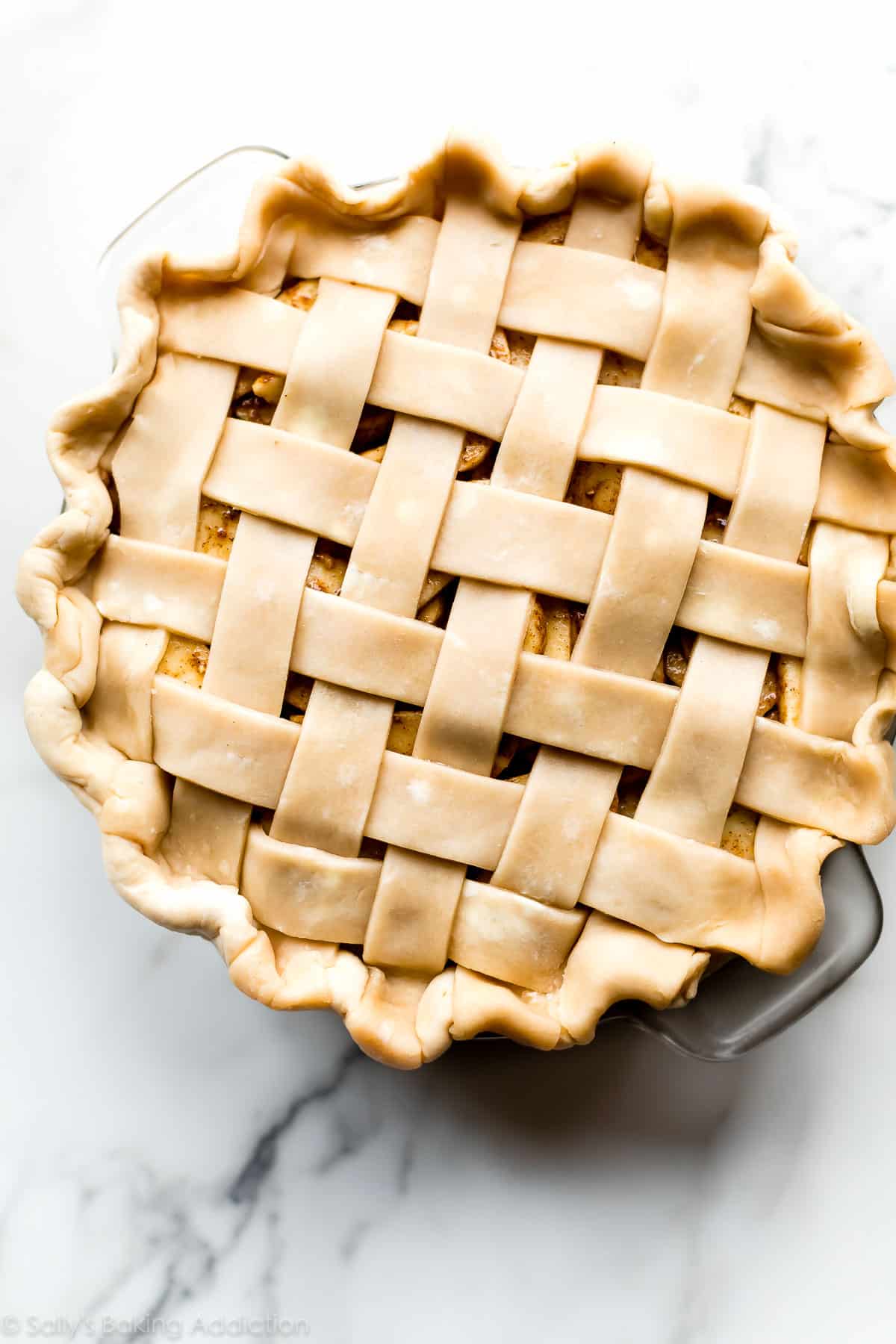
Butter Pie Crust Tips
- I’m going to repeat myself here. Keep all pie crust ingredients cold. On a hot day, you can chill the measured out flour in the refrigerator or freezer before starting. When taking the pie crust out of the refrigerator to roll out and fill, make sure your pie filling is ready to go. If not, keep the pie crust in the refrigerator until it is.
- Glass pie dishes are best. Why? As opposed to ceramic or metal pie dishes, glass pie dishes conduct heat evenly, which allows the bottom of the crust to bake thoroughly. Also, you can see when the sides and bottom of the crust have browned.
- If your pie recipe requires pre-baking (blind bake pie crust)—let’s say you’re making a pie with an especially wet filling—use pie weights or dried beans. Without pie weights, the pie dough will puff up, then shrink. Whichever you choose, be sure to line the crust with parchment or aluminum foil, then fill the empty pie crust with the weights. See my post and video tutorial for how to blind bake pie crust.
- Always use a pie crust shield. A shield keeps the crust edge covered, which protects it from browning too quickly or worse, burning. Use an adjustable silicone pie crust shield that you can fit to the size of your delicate pie crust. Metal can break the crust. Alternatively, you can cover the pie with a piece of aluminum foil. Cut a large circle in the center of the square so the center of the pie is exposed.
- Learn how to braid pie crust with my how to braid pie crust video tutorial.
- Learn how to lattice pie crust, too.
- Last but not least, learn how to crimp and flute pie crust. Those pretty decorative pie crust edges add function and flair!
Pie Crust Troubleshooting
- Prevent a crumbly pie dough that rips and tears when you roll it out. Make sure you use enough ice water when preparing your pie dough. Too little water creates an unworkable dough.
- Prevent a tough pie crust. Tough crusts are the result of not enough fat in the crust, as well as overworking the dough. Use the all butter pie crust recipe or my shortening and butter pie crust recipe to ensure a flaky, tender pie crust. Additionally, don’t work the dough too much.
- Prevent a burnt crust with a pie shield. See above.
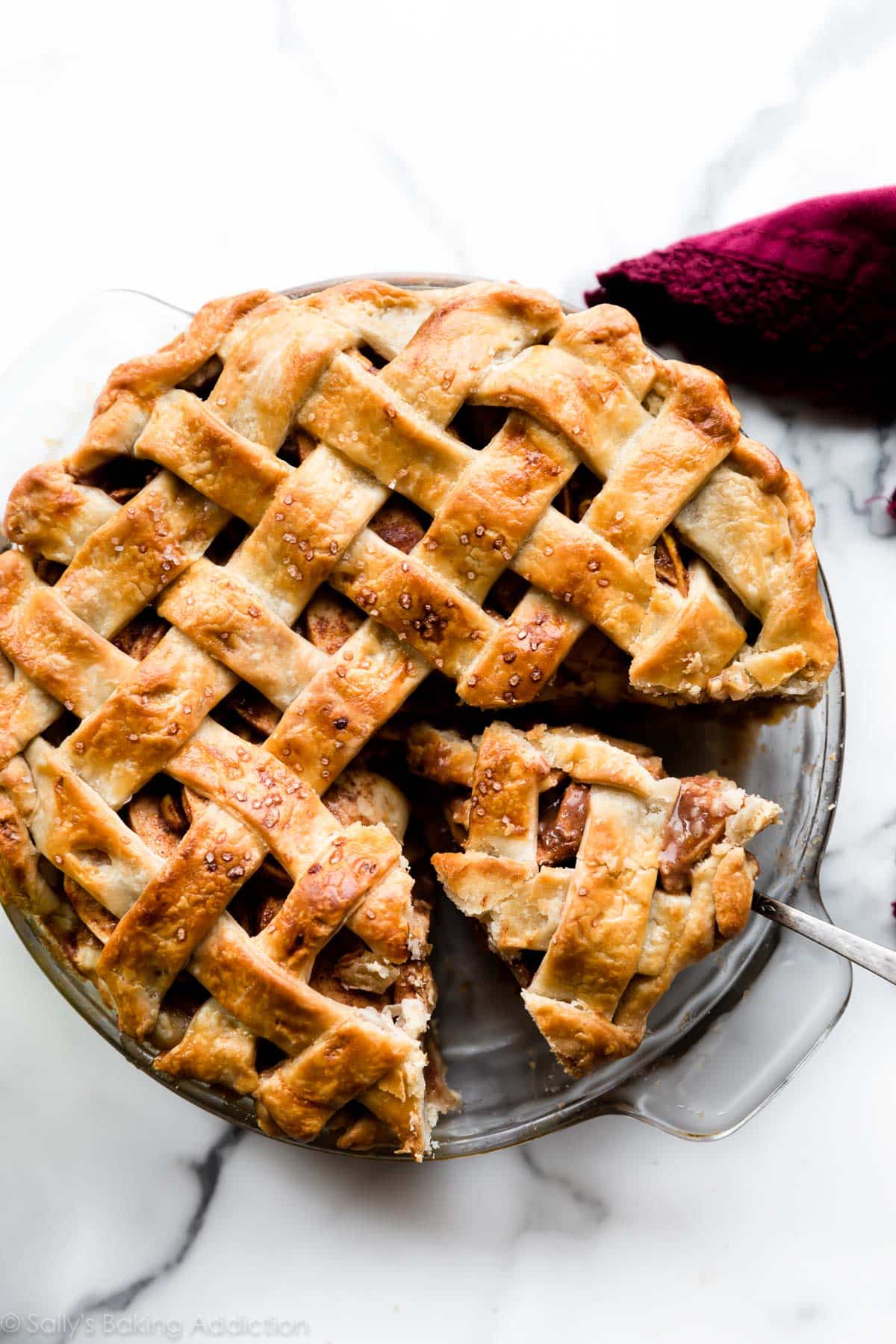
Recommended Pie Crust Tools
(All my recommend products are affiliate links. I trust these tried-and-true tools!)
- Pastry cutter – Though you can use a food processor to make this butter pie crust, I strongly recommend a pastry cutter to avoid over-mixing. Food processors are quick to over-work pie dough.
- Pastry mat – I prefer rolling pie dough out on a lightly floured counter because countertops are usually colder, but you can use a lightly floured pastry mat instead.
- Rolling pin – An obvious must with pie dough! I also love this marble rolling pin. Marble rolling pins are usually cooler to touch and we all know that pie dough loves the cold.
- Glass pie dish – My mother-in-law bought me this Pyrex pie dish 5 years ago and it’s been my go-to ever since. I have 4 of them now! Like I mention in my pie crust tips above, glass pie dishes conduct heat evenly, which allows the bottom of the crust to bake thoroughly. This is important. There’s no comparison, Pyrex is the best.
- Pizza cutter or pastry wheel – To cut your pie dough into strips for lattice decoration or any decoration. Have you seen my pie crust designs post?
- Pastry brush – An egg wash is simply an egg mixed with milk or water (usually milk). Lightly brush the pie dough with an egg wash using a pastry brush. The egg wash creates a golden, shiny, crisp crust. Without it, pie crust is dull and lacking color.
- Pie weights – These are crucial when you blind bake pie crust for no-bake or custard pies. Note: 2 packs of these pie weights is definitely needed!
- Pie crust shield – Pie crust edges are usually higher up than the center of the pie, leaving them exposed to the most heat. They brown quicker than the center of the pie, so it’s important to protect it with a shield. I usually place a pie crust shield on the pie about halfway through bake time. I recommend an adjustable silicone pie crust shield that you can adjust. Or you can cover the pie with a piece of aluminum foil: cut a circle in the center so the center of the pie is exposed.
Pie Recipes
Now that you’re fully prepared and equipped, here are several pie recipes to use your all butter pie crust. Pictured is my chai spice apple pie and I topped it with salted caramel in the video.
- Traditional Apple Pie & Salted Caramel Apple Pie
- Lemon Meringue Pie (a blind bake pie crust recipe)
- Caramel Pear Pie
- Pumpkin Pie
- Pecan Pie
- Banana Cream Pie (a blind bake pie crust recipe)
- Cherry Pie
- Peach Pie
- Blueberry Pie
- Sweet Potato Pie
- Fun recipes: Apple Hand Pies, Brown Sugar Cinnamon Pop Tarts, Pecan Pie Tarts
- Or any of my favorite Thanksgiving pie recipes!

All Butter Pie Crust
- Prep Time: 20 minutes
- Cook Time: 0 minutes
- Total Time: 2 hours, 20 minutes
- Yield: 2 pie crusts
- Category: Pie
- Method: Baking
- Cuisine: American
Description
Follow this simple recipe and video tutorial for the best all butter pie crust. It will make you a pie expert immediately! Complete with all my tips and troubleshooting, this pie crust recipe is buttery, flaky, and tender with the most incredible flavor.
Ingredients
- 2 and 1/2 cups (313g) all-purpose flour, plus more as needed (spooned & leveled)
- 2 teaspoons granulated sugar
- 1 teaspoon salt
- 1 cup (16 Tbsp; 226g) unsalted butter, chilled and cubed
- 1/2 cup (120ml) ice water, plus more as needed
Instructions
- Mix the flour, sugar, and salt together in a large bowl. Add the cubed butter on top.
- Using a pastry cutter, food processor, or two forks (pastry cutter is ideal, see post above), cut the butter into the dry ingredients until all flour is coated. You’re looking for pea-sized bits of flour coated butter. A few larger bits of butter is OK.
- Measure 1/2 cup (120ml) of water in a cup. Add ice. Stir it around. From that, measure 1/2 cup (120ml) of water since the ice has melted a bit. Drizzle the cold water in, 2 Tablespoons (30ml) at a time, and stir after each addition. Stop adding water when the dough comes together easily and begins to form large clumps. The dough will feel moist and a little sticky, but not feel overly wet. Do not add any more water than you need to. I always use about 1/2 cup (120ml) of ice water.
- Place pie dough on a lightly floured work surface. Using floured hands, fold the dough into itself until the flour is fully incorporated into the fats. Form it into a ball. Divide dough in half. Using your hands, flatten each half into a 1-inch thick disc.
- Wrap each disc tightly in plastic wrap and refrigerate for at least 2 hours and up to 5 days before using in a pie recipe.
- When rolling out the chilled pie dough discs, use gentle force with your rolling pin. Start from the center of the disc and work your way out in all directions, turning the dough with your hands between rolls. Smooth out the edges if you notice cracks. (See video above.) Keeping your work surface, rolling pin, and hands lightly floured makes rolling out easier.
- Proceed with the pie per your recipe’s instructions.
Notes
- Make Ahead Instructions: Prepare the pie dough through step 4 and freeze the discs for up to 3 months. Thaw overnight in the refrigerator before using in your pie recipe.
- Special Tools (affiliate links): Glass Mixing Bowl | Pastry Cutter | Silicone Spatula | Rolling Pin | 9-inch Glass Pie Dish | Pizza Cutter or Pastry Wheel | Pastry Brush | Pie Weights | Pie Crust Shield
- Pie Crust Comparison: Let’s see how this all butter pie crust recipe compares to my favorite buttery flaky pie crust, which uses a mix of shortening and butter. Due to butter’s high water content, this all butter pie crust is lighter textured with more defined flakes. As the crust bakes, the butter’s water converts to steam, creating thousands of deliciously light flakes. It’s also so buttery! However, because of all this butter, I find that the shortening and butter pie crust is a little easier to work with. Shortening has a higher melting point than butter, so the crust holds its shape wonderfully. Both crusts are fantastic, but if you are looking to make intricate pie crust designs I highly recommend my buttery flaky pie crust.
- Try This: Replacing 1 Tablespoon of ice water with cold apple cider vinegar creates an even flakier, more tender pie dough. It’s so tasty. Try it!



















Hi Sally,
Thanks for this recipe. It’s so buttery and delicious – I love it. I was using it to make savory hand pies, and the trouble I keep running into is the the butter keeps leaking out in the oven whenever I roll the crust thin. Not super thin, maybe 1/8 inch. Doesn’t happen as much when I roll it thicker but then it doesn’t cook properly and takes away from the overall texture I’d like for the pie. I do keep the butter super cold and put the filled pie in the freezer for 20 minutes before sticking them in the oven. Any advice on how I can get a thin pastry on the bottom without the butter leaking out? I was thinking maybe the butter pieces in my dough were too big and I should I try the grated frozen butter technique instead? Novice pie baker here, would love the advice! Thanks!
Hi Mahima, when the pie dough is thicker, it has more structure. When it’s thinner– and if the pieces of butter are too large for the thickness– the butter will leak and/or the crust will taste greasy. I recommend working the butter into the dough more or starting out with smaller pieces of butter. Grating the butter with a box grater is a great idea in this case.
The best and flakiest pie crust I’ve made to date! Definitely a new go-to, thank you!
I tried this recipe and it is now my go-to crust recipe. Everyone raves about the flakiness and buttery taste. The last time I made it, I tried a trick I had read about: I shredded semi-frozen butter using a cheese grater before adding it to the dry ingredients. It was much easier to incorporate the butter and the crust came out even flakier than before.
Hi Sally, This was the first pie I’ve ever made. HUGE SUCCESS. I made pecan pie with all butter pie crust. I couldn’t believe how golden brown the bottom crust was, and how many beautiful flaky layers in the crust. QUESTION: Second pie dough in fridge is now 7 days old. Can I still use this? Also, can you do a slow-mo video on crust crimping? Thank you for the recipe with all the great baking tips.
Hi Colleen! I’m so happy to read how much you enjoyed the pecan pie with this crust. You’ll be fine to still use that 7 day old crust in the fridge, though I know it’s been more than 7 days at this point. I usually say 5, but a few extra days is just fine. I don’t have a video for crimping pie crust edges with a fork, but you can watch me flute the edges in several of my pie videos. A good one is in my French Silk Pie recipe post. Starts at about the 1:14 minute mark.
This is a truly fantastic pie crust- it’s the flakiest pie crust I’ve ever gotten from an all-butter crust! When I use it for mini pies, it’s almost in-between pie crust and puff pastry as it’s so flaky, which my idea of a perfect pie crust. I love how detailed the recipe instructions are- they are easy to follow and help ensure a good result. This pie crust is the best of both worlds in terms of the flavour of an all-butter crust but a consistency similar to a shortening crust. This has replaced my old recipe as my go-to pie crust, it’s fabulous!
Thank you so much for sharing–its a fabulous recipe! It turned out perfectly!
Can this recipe be changed to fit a 12″ pie crust instead?
Hi Mary, This recipe yields two 9-inch pie crusts. You can certainly try to roll it all out together to make one larger crust.
Hello,
What size pie dish shall I purchase for this recipe?
Please and thank you!
9 inch is best.
The pie turned out brilliantly, you are awesome! Thank you for the advice r.e. chicken pie with this crust! I found out that my sister learned how to make incredible bread via your website too! I have one more question- for this beautiful pie, would you recommend a LeCreuset stoneware baking dish? Or would you pick a glass one over that?
Hi Vera, We are so glad both you and your sister have used these recipes! If given the choice, glass pie dishes are best. They conduct heat evenly, which allows the bottom of the crust to bake thoroughly. Also, you can see when the sides and bottom of the crust have browned 🙂
This was the best pie crust I’ve ever made (even better than my grandmas, shhh!). Thank you for all of your wonderful recipes Sally, I always trust that they’ll turn out incredibly 🙂
Hi Sally, if I wanted to use this to bake one galette, should I halve the recipe or use the whole recipe? What size would it make? I’m assuming baking at 400 for 35-45 minutes would be sufficient.?
Hi Stacey! You can halve the pie crust recipe or freeze the 2nd pie crust since this is enough dough for 2 9-inch single crust pies. 1/2 of the recipe will yield one 9-inch galette. The bake time depends on how much filling you use and what the filling is.
Hi Sally!
I am interested in making this all butter pie crust for your mini quiche recipe. I am wondering if I need to ‘blind’ bake the mini crusts before adding in the quiche mixture? I never know when to blind bake… Is it just standard practice with pie crust, or only when the recipe explicitly states to do so?
Thanks in advanced! 🙂
Hi Brooke, No need to blind bake the crust for mini quiches! If a recipe doesn’t state the need to blind bake then it’s usually not necessary. If you are interested here is more information on blind baking pie crusts.
Hi Sally ! To use this pie crust in a savory recipe, like your chicken pot pie, do I omit the sugar ?
Hi Julie, You can use it as written for chicken pot pie (or any savory recipe). It’s not a sweet pie crust.
I just love your recipes and your vibe. Keep up this wonderful work!
Hi Sally! Will this recipe be enough if I am using 10 inch pie pan? Thank you!
Hi Risse! This recipe yields 2 pie crusts for 9 inch pies. (1/2 of the recipe for 1 pie.) You can use 3/4 of this dough to ensure you have enough for your 10 inch pie.
I should make 1 1/2 of this recipe for me to have enough for two 10 inch pies then? Thank you so much!
Hi Sally!
Ist attempt at pie crust! It was a bit chewy and never browned on top, despite the use of the egg wash. The filling (your cherry pie recipe) has amazing flavor but was wet and didn’t set after 3 hours of cooling. What did I do wrong??
Hi Katharine! Since the crust tasted chewy, didn’t really brown, and the filling was wet, it sounds like the pie wasn’t finished in the oven– don’t be worried if your pie takes longer than what a recipe suggests. All ovens are different. Even 10 more minutes in the oven would help for next time. Thank you so much for trying this!
I only used about 50 ml of water but my dough is still already coming together. Is this strange? What am I doing wrong?
Hi Anna, I wonder if the butter was either (1) too warm or (2) worked into the dough too much. Either would make a wet dough even before you add water.
Hi Sally! This recipe looks great. I’m doing a test batch now before I go pie-crazy for father’s day. I worked the dough a bit to combine the butter and flour a bit more, but it came out quite crumbly. I didn’t want to add too much extra water, I think I added 1 extra tablespoon. It has been in the fridge for about an hour now, and still cracks when I try to pick it up. What did I do wrong? How can I fix it?
Thank you very much 🙂
Hi Denise! Cracked pie dough is easily fixable and I’m glad to help. If it’s cracking, moisten your fingertips and bring the cracked edges back together. Cracked pie dough is dry, so a little moisture will help. I always use my fingers to “meld” any cracks back together– as if it were play doh.
Hello! I saw that in your other pie crust recipe you discussed using vodka as a replacement for some of the water – I’m wondering if that might be something you’d suggest for this recipe as well? Thank you!!
Yes, you can do the same here if you wish!
What temperature do I blind bake the crust?
Unless a recipe calls for another temperature, I usually blind bake pie crust at 400°F (204°C).
“Silent Crust”. You can mix the pie crust by SHAKING. My husband was on a Video Conference call and I could not use my food processor because of the noise. Well….if you add grated frozen butter to the dry ingredients and shake in a tightly sealed container. Then add the cold water, you will create the ‘silent crust.’
Why do we grate frozen butter for scones, but cube cold butter for pie crust? If pie crusts need to be cold, why not grate frozen butter for them as well?
Hi Mollie! You can certainly use grated butter for making pie crust, just like we do for scones. However, I don’t like using cubed butter for scone dough because you can quickly over-work it which leads to flat, dense scones. You have more wiggle room with pie crust since it doesn’t rise as much.
Oh my! This was my first time making pie dough from scratch and I didn’t have lard like most recipes call for. I usually just buy some pre-made crust and call it a day, but I decided to give it a shot. I searched for a recipe using butter and came across your recipe. My pie crust is the bomb! I made an apple cobbler and it’s delish. Thank you so much!
Sally, this is seriously awesome!!!! Thank you!!! The crust recipe used here and the one used in chicken pot pie- what is the difference? Can vodka be used in this crust for pecan pie too?
Hi Vera, The Homemade Buttery Flakey Pie Crust used for the chicken pot pie recipe uses both butter and shortening. This recipe uses all butter (with no shortening). You can use either! Yes, many people use vodka. See the paragraph in the post for Buttery Flakey Pie Crust called “Vodka in Pie Crust” for tips!
Thank you, Sally!!
After many terrible attempts at pie crust over the span of many years …this recipe is amazing. Followed the directions and the whole time I am thinking that it is sooo fun because it felt and looked superb. I even used whole wheat flour and it was a gorgeous dough. Yay, Sally!!!!!
Hi Sally, fantastic recipe thank you. It was my first time making pie crust from scratch. It turned out beautiful and flaky, gorgeous. I used only top layer (saved the 2nd one for next time) and had chicken and mushroom for filling. It is easy to make and very delicious, a definite keeper. I am going to try the apple pie next 🙂
I was kind of mad that my local store didn’t have pie crust, so I looked up this recipe in a pinch. I’m pretty glad because it was much better than the store-bought stuff and pretty easy to whip together. I did have to add a splash or two more of water since mine wasn’t coming together, but it was very delicious. Thanks.
Hi Sally, do you think this pie crust would work for a savory pie like chicken pot pie?
Thanks!
Absolutely! Here is my favorite chicken pot pie recipe.
I Wanted to make a chicken pie then realized I didn’t have shortening so was so thrilled to find this all-butter recipe. Followed the instructions and the pie turned out so well!! I don’t have too much experience making pastry so I was really happy with the results. Thank you Sally, your recipes continue to help me be a better cook and Baker every time!!
Hi Sally,
I made your apple pie using your all butter pie crust recipe. It was a success! I loved how easy it was to roll out the pie crust, and definitely can’t wait to make another pie. Thank you so much for all your videos that really helped me to overcome my fear of making pie crust May I ask if this all butter pie crust is suitable for savory pies, such as chicken pie too?
I’m so happy you enjoyed the apple pie, Stephanie! For my Chicken Pot Pie recipe I use my Homemade Buttery Flaky Pie Crust which is a combination of butter and shortening, however you can use this all butter crust if you wish.
Thanks for your reply, Sally. Another question – is this all butter pie crust the same as shortcrust pastry crust? Can I use it in place of all recipes that calls for shortcrust pastry crust? Thanks again!
I’m not sure if I just live in a very warm area or if I just have hot hands but the butter always ends up melting when i’m forming the dough ball :(. If I put the crust in the refrigerator/freezer, will the butter become resolidified or at that point is the butter to dispersed in the dough to become solid again?
Hi Sam! What may be helpful is to chill the dough right after you add the ice water, before using your hands to form into a ball– this way it will be even colder, so even if you have warm hands, all won’t be lost.